The Great Battle of Kursk: a defensive operation by the troops of the Voronezh Front. Part of 2
On the night of July 6, the command of the Voronezh Front decided to strengthen the defense of the 6th Guards Army with corps of the 1st tank army of Mikhail Katukov. The 3rd mechanized and 6th tank corps covered Oboyansk direction. In addition, Chistyakov’s army was strengthened by the 2nd and 5th Guards Tank Corps, which began to reach the flanks of the army. These corps included about 850 serviceable tanks, and they could have a serious impact on the course of the battle.
On the second day of the battle, Nikolai Vatutin, as well as Konstantin Rokossovsky, planned to inflict counterattacks on the German assault groups. Katukov’s 1 Panzer Army was to strike in the general direction of Tomarovka. German troops had not yet penetrated the front line, and the command of the Voronezh Front wanted to stop them on the second line. Vatutin wanted to start a counter battle. The 1 Tank Army counterstrike was canceled at the proposal of the Headquarters. The commander Katukov agreed with this decision, believing that it was more expedient to use armored vehicles to reinforce the defenses by trenching them or setting them in ambushes, where they could allow enemy tanks to close.
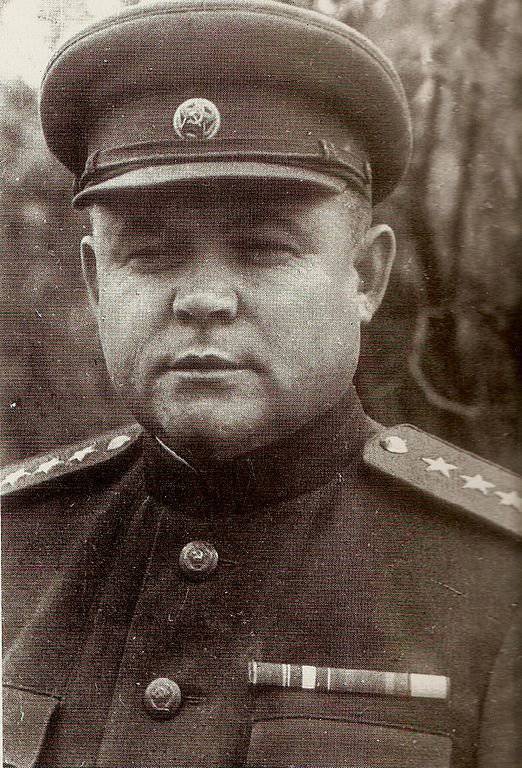
Army General - N.F. Vatutin, 1943
The breakthrough of the 2 SS Panzer Corps to the third line of defense. On 6 July, the SS units received the following tasks: The 3 2nd SS Panzer Division "Dead Head" was to defeat the 375 Infantry Division and expand the breakout corridor in the direction of r. Linden Donets; The 1 Tank Division Leibstandard Adolf Hitler and the 2 Tank Division Reich are to break through the second line of defense from Yakovlevo, where 51-I Guards Rifle Division, Major-General Nikolai Tavartkeladze, occupied the defense, and go to the line of the bend. Psel - with. Teterevino. In addition, part of the forces of the Leibshtandart division had to be allocated to guarding the flank, since the 48 tank corps advanced more slowly than the 2 SS tank corps.
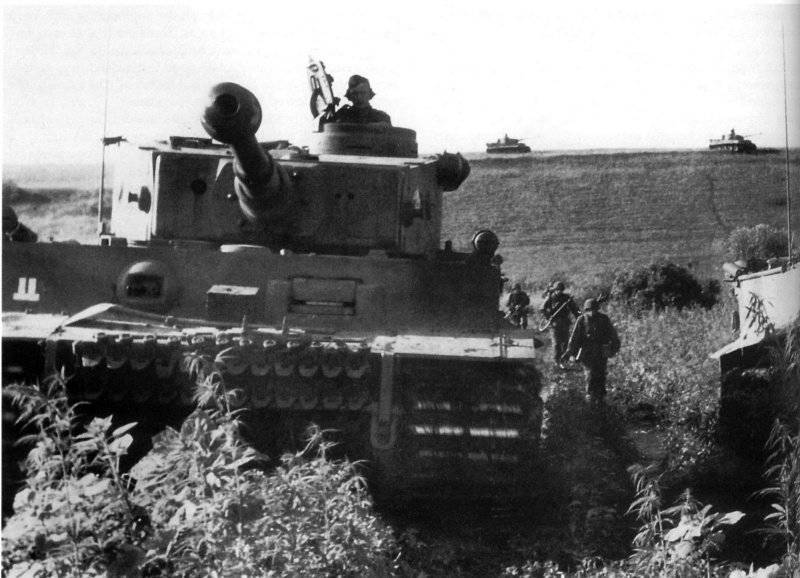
Tanks Pz.Kpfw. VI "Tiger" SS armored division "Das Reich" on the Kursk Bulge.
The defense sector of the 51 Guards Rifle Division (the former 76 Rifle Division, transformed into the Guards for resilience, courage and heroism in the Battle of Stalingrad) was the weakest in the defensive orders of the 6 Guards Army. She occupied the defense in the second echelon of the army and was responsible for the 18-kilometer sector of the front. All the regiments of the division had to be pulled out in one line, without allocating one regiment to the reserve. Arriving at this site of the 5 tank guards tank corps of Lieutenant General Andrei Kravchenko’s tank forces (three tank and one motorized rifle brigades) was supposed to seriously strengthen the defense in this direction. The problem was that the corps did not have enough transport, and the unit did not have time to arrive at the beginning of the battle in full force. Having marched 60 km, by 6 in the morning of July 6, the 5 corps was in position behind the 51 Guards Division. 213 tanks arrived, several vehicles were left behind, for technical reasons, or because of a shortage of crews. Tankers have started digging machines. The situation was worse with the infantry of the 6 th guards motorized rifle brigade, the soldiers went on foot and did not manage to reach the position by the beginning of the battle.
The German command chose to hit a relatively small 3-kilometer section, which was attacked by units of the Reich and Leibshtandart divisions. Here the defense was kept by the warriors of the 154 and 156 of the Guards rifle regiments. Initially, the artillery of the corps of Hausser dealt a powerful blow to the positions of the guards division. At the same time, the aircraft 8-th air corps - groups in 50-80 machines, turned the "damn wheel". German bombers lined up and, replacing each other, struck at the Soviet troops. At the same time, German intelligence was able to identify points of control and communications regiments of the Guards Division. They were hit hard. This led to the disruption of communications and the management of regiment battalions. In fact, the units of the regiments reflected the enemy offensive without contact with the higher command.
Powerful artillery and aviation strikes, the numerical superiority of the enemy in the breakout area (two German tank divisions against two guards rifle regiments), skillful interaction between artillery, aviation, tank and infantry formations, the use of heavy tanks and assault guns, led to the success of the SS corps. Tank formations went on the attack about 11 hours, after two and a half hours it was all over, the battalions at the junction of the two rifle regiments were shot down and began to retreat in the direction of the villages of Yakovlevo and Luchki. The battle and retreat were accompanied by heavy losses of the guard units. In particular, in the 156th Guards Rifle Regiment of 1685 people, by July 7, only about 200 people remained in service, that is, the regiment was practically destroyed. As a result of the battle, of the 8,4 thousand people who were in the division on July 1, 1943, by July 7 only 3,3 thousand soldiers and officers remained in service.
The left-flank 158-th Guards Rifle Regiment bent its right flank and was able to maintain its order. Some units of 154-th and 156-th went to the location of neighboring divisions. Several divisions shot down the German offensive divisions, giving the infantry the opportunity to save and gain a foothold on the new frontiers, Soviet artillerymen: the artillery of the 51 Guards Rifle Division - the howitzer batteries of the 122th Guards Artillery Regiment of Major M. Uglovsky and the artillery of the 5th Guards Artillery Regiment of Major M.N. tank corps - artillery units of the 6 th guards motorized rifle brigade of Colonel A. M. Schekala. By holding back the enemy’s attack, the Soviet artillerymen were able to retain most of their weapons. A fierce battle took place over the village of Luchki, where the 464-th Guards Artillery Division and the 460-th Guards Mortar Battalion of the 6-th Guards Motorized Rifle Brigade managed to occupy their defenses. The infantry of the brigade, due to insufficient provision of vehicles, was still on the march in 15 km from the battlefield. In 14: 20, units of the Reich Division occupied the village, the Soviet artillery moved north to Kalinin Farm.
After that, right up to the third defensive line of the Voronezh Front, in front of the 2 tank corps of the SS, there were no 6-th Guards Army units that could restrain its advance, except for the tank formations of the 5-th Guards Tank Corps. The main forces of the anti-tank artillery of the army were located in the offensive zone of the 48 tank corps. After the left flank of the 6 Army Chistyakov was crushed and the second line of defense was broken, the front command, in the conditions of incomplete clarity of the situation, made an ill-conceived decision to stop the breakthrough. After Commander Chistyakov reported on the situation on the left flank of the army, Vatutin orders the transfer of the Kravchenko 5 Corps and the Burdeyny 2 Guards Tank Corps to the operational control of the 6 Guards Army Commander. The front command approved the proposal of Chistyakov on applying a counterattack on the erupted forces of the 2 SS tank corps with parts of the 5 TS and 2 Guards tank tanks.
Ivan Chistyakov set the task for Krakchenko’s commander to withdraw troops from the defensive area he occupied, where the tank crews were preparing to meet the enemy, relying on strongholds and using ambush tactics. In fact, the corps was asked to enter into a counter battle with the superior forces of the enemy, on unfavorable terms. The commander and headquarters of the 5 Guards Tank Corps, better aware of the current situation and the capture of the division "Reich" with. Lucky, tried to challenge this decision. However, under the threat of arrest were forced to execute this order. To understand the resistance of the command of the 5 corps, the order of the commander should recall the serious difference in the organization of the Soviet tank corps and the German tank division. Each division of the 2 SS Panzer Corps had up to 20 thousands of people. The Soviet 5 th Guards Tank Corps totaled thousands of 9,5 people before the battle (according to the 10,2 staff, thousand people). A particularly significant difference was in the provision of the Soviet tank corps and the German tank division with infantry and artillery.
The 5-th Guards Tank Corps could perform its task much better if it had managed to unite its tank formations with the infantry of the 51-th Guards Rifle Division of Tavartkeladze. In addition, the 5 tank corps did not have time to link the actions of tank corps brigades with its neighbors and aircraft. Tank brigades went to the counter-attack without artillery preparation, without the help of the Air Force, with open flanks and in the open, convenient for firing long-range tank guns of German tanks. The result was obvious.
In 15.10, the 5 Guards Tank Corps launched a counterattack. The enemy was attacked by the 22 and 21-I Guards Tank Brigades and the 48-th Guards Heavy Tank Regiment. The German command easily reflected this blow. The SS division "Reich" regrouped, put up tanks as a barrier and caused the Luftwaffe, who mixed the combat order of the Soviet formations. Pulling up anti-tank artillery and organizing a flank maneuver, the German troops went around the Kravchenko corps’s tank brigades and entered them in the rear. By 19 hours, SS units occupied Kalinin farm, cut off communications of the defending tank brigades, cutting them off from the corps headquarters. In fact, most of the 5 Guards Tank Corps was surrounded between. Luchki and Kalinin farm. The Germans are developing the offensive, acting in the direction of Art. Prokhorovka, made an attempt to seize the Belenikhino junction. However, the command of the 20 th Guards Tank Brigade (lieutenant colonel PF Okhrimenko) who remained outside the ring of the environment managed to create a strong defense from various units of the 5 corps. The German attack was repelled, the enemy was forced to roll back to Kalinin.
Another strike group of the Reich division, using confusion during the withdrawal of Soviet units, reached the third army defensive line, which was defended by units of the 69 Army. Near the farm Teterevino, the German troops briefly penetrated the defenses of the 183 Infantry Division, but due to lack of strength, having lost several tanks, retreated. The appearance of German troops at the turn of the third line of defense on the second day of the battle was regarded by the Soviet command as an emergency.
On the night from 6 to 7 in July, the surrounded parts of the 5 Guards Tank Corps made a breakthrough and in small groups made their way to their large part. During July 6, the corps lost its destroyed and burned 119 tanks, several more tanks were lost for unknown reasons or due to technical malfunctions. More 19 tanks were sent in for repair. These were the highest losses of the Soviet tank corps during the entire defensive operation on the Kursk Bulge in one day of fighting.
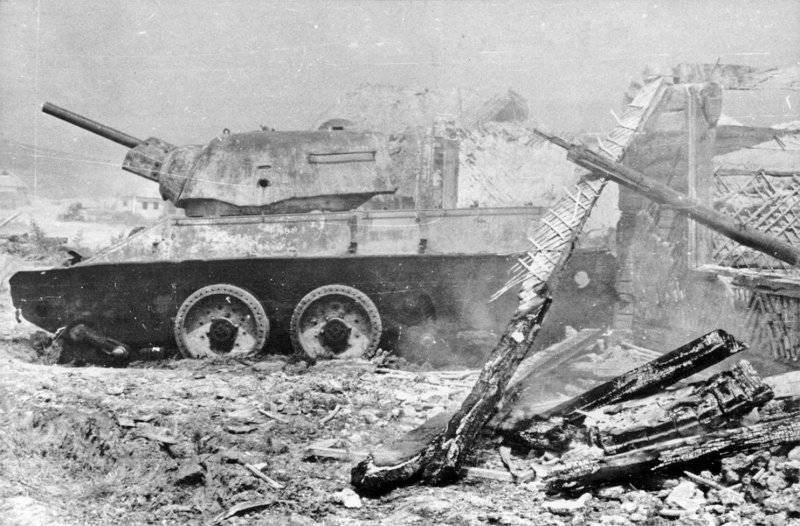
Soviet tank T-34-76, padded in a village on the Kursk Bulge.
The Soviet troops managed to stop the expansion of the breach by a strip from Yakovlevo to the railway. From the right flank a counterattack was struck by the 3 th mechanized corps of the 1 th tank army, from the left - the 2 th Guards Tank Corps. Also on the flank position of the SS tank corps was the 28 th anti-tank brigade. The resistance of the surviving 122 Guards Artillery Regiment from the 51 Guards Division, and the artillery units of the 5 Guards Tank Corps also played its role.
The general course of the defensive battles on the southern fase of the Kursk Bulge. Fighter tanks "Marder III" follows by the exploded medium tank MH "Li".
Counterstrike 2 Guards Tank Corps. The 3-i Tank-Grenadier Division of the SS “Dead Head” did not achieve such successes as the other divisions of the corps during 6 July. This was due to the stubborn resistance of the 375 th rifle division and the counter assault of the 2 Guards Tank Corps under the command of Colonel Alexei Burdeyny held in the second half of the day in the defense zone. The 2 th tank corps counter-attack took place simultaneously with the Kravchenko counter-attack corps, but ended more successfully. The Dead Head Division was tied by this battle, and it had to attract some units of the Reich Division to repel the attack. The balance of forces was in favor of the German division, but Burdeynoi corps acted in cooperation with the 375 th rifle division, which saved him from immediate defeat.
Prior to the start of the battle, the 2 Guards Tank Corps was stationed near the town of Korocha. It consisted of: 4-I, 25-I, 26-I Guards Tank, 4-I Guards Motorized Rifle Brigades, 47-th Guards Heavy Tank Regiment breakthrough, and other connections. Depending on the situation, they could have sent him to the aid of the 6 or 7 of the Guard armies. In 17.30 5 July, the corps headquarters received an order to advance to the left flank of the 6 Army. The corps of Burdeyno was to take part in a frontal counterattack. The deployment of corps units took place at night, so the German command did not immediately detect the appearance of a new Soviet mobile unit. Despite some loss of materiel for technical reasons, the 2 th Guards Tank Corps had 6 tanks, including 1943 T-265, at the start of the July 90 counterattack.
The 375 Rifle Division did not take part in the attack. Her regiments were already stretched out in one echelon, and the violation of the division’s battle formations was too dangerous a decision. The connections of the SS Tnenkopf 3 Tank-Grenadier Division and the 2 Guards Tank Corps exchanged several blows. Some parts of the Burdeynoi corps were surrounded for a short time. But the hull losses were not serious - 17 tanks burned out and 11 destroyed. The 2 Guards Tank Corps maintained its combat capability. The 2 Guards Tank Corps, supported by the still efficient 375 rifle division, became a threat to the right flank of the 2 SS Tank Corps.
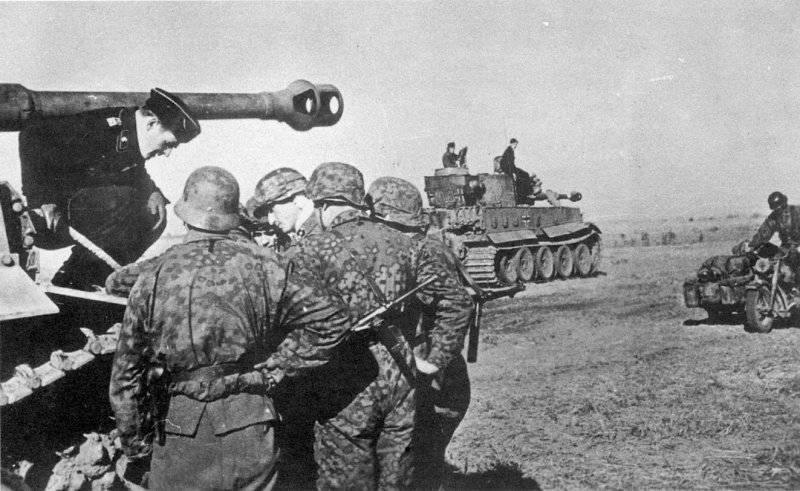
The SS Ttenkopf SS 3 Division is discussing a defensive action plan with the Tiger commander from the 503 Battalion of Heavy Tanks. Kursk Doug.
To be continued ...
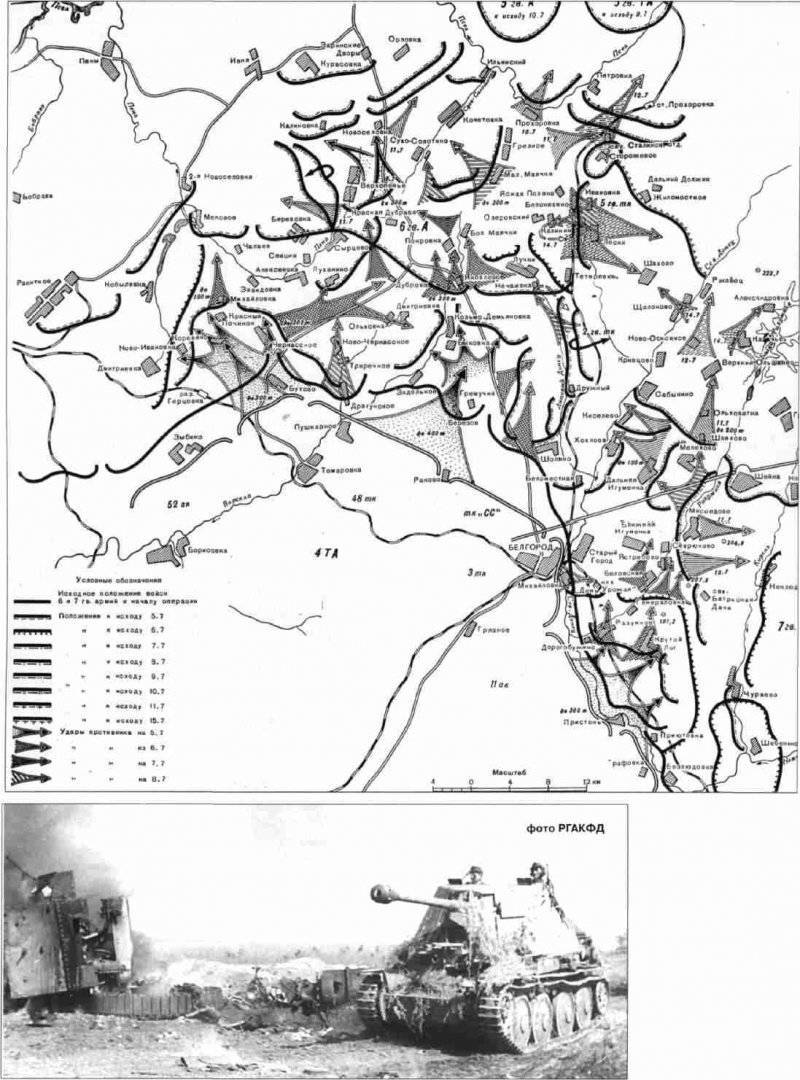
Information